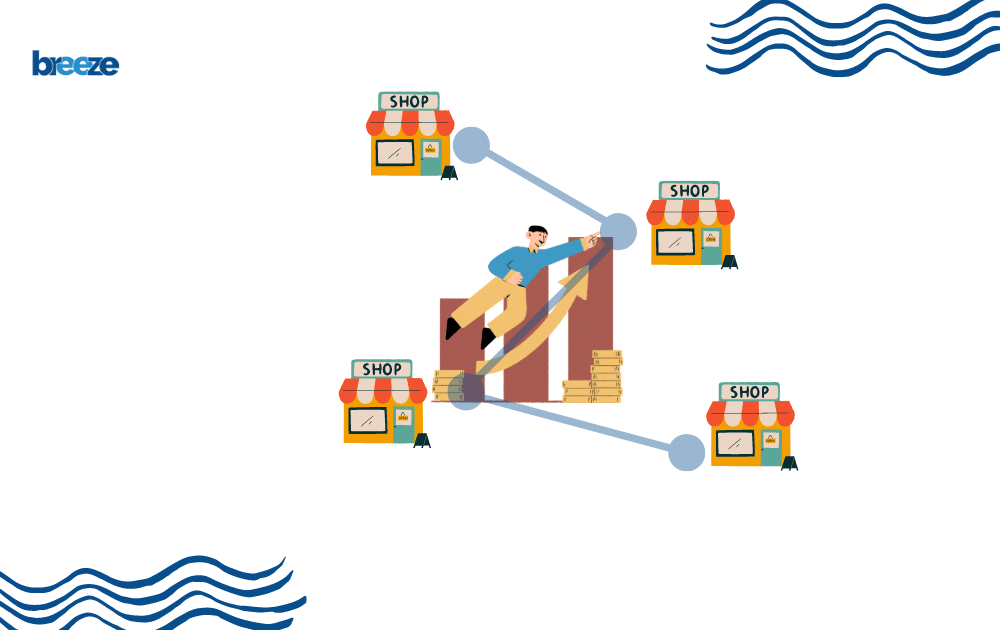- Payel Adhikary Ghosh
- Field Sales Management, travelling salesman problem
- 0 Comments
- 1116 Views
You might be expecting a foolproof formula to optimize your sales route. Why not go back to basics? When planning route optimization, where your field agents will cover the maximum market area or all the assigned outlets and return to the original spot in the shortest possible time, we are looking for the best approach. Starting with the Travelling Salesman Problem (TSP) is the most effective way to achieve this.
The Travelling Salesman Problem definition says it is a well-known problem in optimization, computer science and operations research. It is defined as follows. For instance, there is a list of cities and distances such that each pair distance will be given. Now we have to find out the shortest possible route that visits every city exactly once. And also after visiting all other cities it should return to its start point in minimum cost
Although, the TSP is an example of an NP-hard search problem. This means that no solution algorithm is known that quickly finds the optimal tour for all instances of this problem(type P). Nevertheless, one can try different ways to find either approximate solutions or even (in the case of smaller instances) exact results.
History and significance of TSP
The Travelling Salesman Problem (TSP) has a long history as being known from the 1800, since mathematicians made it into a challenge. The real importance of this lies in its practical use across industries. Whether you are dealing with logistics, transport, manufacturing or say even DNA sequencing!
In the following years, TSP has been one of the most important problems that attract researchers and computer scientists in combinatorial optimization. Today, thanks to ever-more sophisticated algorithms and computing power, an ability to solve TSP effectively can matter a great deal for companies that want to cut costs by rationalizing their routes.
Interesting because TSP is computationally complex. That means travelling salesman problem is an example of a sales agent finding it very difficult to find the shortest path that visits each location exactly once. We can observe this challenge has driven innovation in algorithm design and we see new techniques such as dynamic programming, genetic algorithms applied to solve TSP variants.
In the day and age of everything going digital and better. Is it always good to learn about how these things emerged? And if it’s already there, what are we learning from its past (TSP) which will reflect over some strategic approach while planning a route on big scale operations in your fleet.
Understanding the problem: What is a field sales agent trying to achieve?
Our travelling field sales agents are on a mission. They need to find the most optimal route and travel through multiple outlets in such a way that he comes back home. Picture him moving through crowded streets, twisting alleys and infinite opportunities trying to find how to get from point A to B in the quickest time for the lowest possible fare.
His goal? We can do this by visiting each outlet exactly once before heading back to our start. Sounds simple enough, right? Well, not quite. The real challenge here is to find the right sequence of outlets, which doesn’t only sum up a mile but also deals with factors like traffic between 2 spots and other conditions.
How can the salesman solve such a complex problem? There are hardly possible combinations to consider, from which only molecular biologists can manually generate and select components. But it is much more than drawing lines between points on a map; it’s the ability to think, plan and make decisions with logic, insightfulness and accuracy.
Methods of using Travelling Salesman Problems
The travelling salesman algorithm is a classical optimization problem, and numerous algorithms have been devised for the same. Travelling salesman problem algorithm may be classified into one of the three:
- Exact Algorithms
- Heuristic algorithms
- Metaheuristic Algorithms.
Popular methods to solve TSP are listed below:
Exact Algorithms
Brute Force Method
Explanation: Here, for every permutation(distance) between the cities, we take that value which takes minimum distance.
Pros: Guaranteed to find the optimal solution.
Cons: Computationally expensive, particularly for a larger number of cities. The time-complexity here is factorial.
Dynamic Programming (Held-Karp algorithm) for traveling_salesperson with 4 cities:
Approach: In this approach, we will break the problem into smaller subproblems and solve each of the subproblems only once and store those results as well.
Pros: It is an efficient way than the Brute force. The time complexity of this algorithm in Big-O notation becomes O(n^2 * 2^n).
Cons: Still infeasible for large instances (those of size much larger than the exponential will still grow exponentially).
Branch and Bound:
Definition : Tree search algorithm that finds the optimal solution by examining all branches of a decision tree while ignoring further branches when Uniform cost skill found its best possible solutions.
Pros: It can be much faster than brute force for the given instances.
Cons: Again, the performances are determined by the problem’s structure and how well we can prune Clauses.
Heuristic Algorithms
Nearest Neighbor
Description: A path starts from a random city and visits the nearest unvisited city. The process is repeated until all cities are visited.
Pros: Simple and fast.
Cons: It does not ensure the best solution and in some cases can be very far from obtaining the optimal one.
Christofides’ Algorithm:
Description: A minimum spanning tree is computed, the minimum weight perfect matching for odd vertices is found and these are modified to become a tour.
Pros: It provides a solution, which is required to be within 1.5 times the optimal solution value
Cons: Not simple like nearest neighbor but still relatively compute-bound
Insertion (e.g., Cheapest Insertion) Heuristics:
Description: Adds a tour by successively adding the city that causes the least change in tour length.
Pros: This is more flexible and often gives better solutions than the nearest neighbor.
Cons: However, normalization itself may still become suboptimal and take more computation.
Metaheuristic Algorithms
Simulated Annealing:
Description: Similar to the annealing process in metallurgy. One that starts from an initial solution and makes random changes to the solutions while allowing acceptance of worse solution with probability = exponential(period/temperature)
Pros: Escape local optima
Cons: Depends on the cooling schedule, and perhaps others
Genetic Algorithms:
Description: Applies the idea of evolution to a population of solutions. It’s a process that combines and mutates (changes) previously found solutions to create new ones.
Pros: Works well for large and complex problems, capable of exploring a great number of potential solutions
Cons: Requires careful observation
Ant Colony Optimization:
Description: Models the foraging behavior of ants. Probabilistically constructs solutions by following pheromone trails.
Advantages: Effective in finding quality solutions and derives good results from the collective forces of diverse skill sets.
Cons: Can be computationally intensive
Tabu Search:
Descriptions: Applies a local search technique, using memory structures (tabu list) to prevent visiting recently visited solutions.
Pros: Can help escape local optima to find good solutions.
Cons: the performance is based on how big and well maintained your tabu list is.
Hybrid Approaches
Combination of Methods:
Description: This consists of combining various techniques. For example, use a heuristic to start with an initial solution and run a metaheuristic from this point on.
Pros: Can derive better result as it used the good part of each methods
Cons: More complex to implement and tune
Three Effective Methods Can Be Used For Sales Route Optimization
Nearest Neighbor Heuristic
Using this method to find the shortest path to all points is guaranteed to work. It iteratively picks the nearest unvisited point until none are left!
Pros:
- Simple and fast to implement.
- Gives you a cheap and fast option.
Cons:
- Does not in general yield the optimal solution, particularly for large numbers of locations.
- Suitable for small to medium-sized problems where quick decisions are necessary.
Genetic Algorithms
Metaheuristic based on biological process, which considers the principles of evolution via natural selection and genetic inheritance to avoid local optima solutions in each generation with population of routes.
Pros:
- Can handle large and complex problem instances.
- (often) Explores a large solution space. Focuses globally and can avoid getting stuck at local optima.
Cons:
- Needs to be tweaked precisely with values such as mutation rate, population size
- Computational edge case: this may be a problem for really large datasets, or super low latency applications.
Ideal Use Case: If you are more concerned with finding a high quality solution compared to how fast that solution is found, this may be useful for large-scale route optimization.
Tabu Search
The method is able to use the new beta-value due to the local search procedure, which also repeatedly investigates neighboring solutions through memory structures not revisiting fully recently investigated solutions. Steps:
Pros:
- Are able to break out of local optima and find solutions of high quality.
- Flexible: medium to large scale efforts are efficient and effective
Cons:
- Performance highly depends upon how the tabu list is managed and how large it’s kept.
- It needs fine tuning parameters.
- Rather suitable for: medium to large problems where we are seeking iterative improvement of the solution, quality of the output is a concern
How can TSP help brands looking to manage their field sales?
Field sales management can use the TSP to optimize their travel routes & will reap benefits in terms of increased route efficiency, lower travelling expenditure and higher productivity from all sales representatives. Here is how TSP can be leveraged for field sales management
Route Optimization
TSP will help to find the shortest route that starts at a certain sales point, visits all the other points exactly one and returns to its place of origin.
Use TSP algorithms to implement the shortest possible route required to visit all sales locations.
Benefit: Because you are reducing the travel time and cost, sales representatives save more time at client places not on the road.
Territory Management
You can create optimal and balanced sales territories that can be assigned to the Sales Representative.
TSP on each territory to ensure that all the routes inside of any territory are small-lengthed.
Benefit: It provides an even distribution of work to prevent overlapping that reduces the redundancy in traveling.
Sales Visit Scheduling
You can schedule the clients visit so you get maximum visits with minimum travel costs.
The system can use the travelling salesman problem (TSP) to generate an optimized schedule that would fit in working hours for each sales representative.
More client interactions per day can be done, resulting in more leads and improving customer’s overall satisfaction.
Real-Time Route Adjustment
Dynamically update routes when they are modified for real time changes such as canceled orders or last-minute orders.
Employ TSP algorithms, heuristic or metaheuristic, that allow the route to be re-optimized fast when updated with new data.
Resource Allocation
It’s easier to optimize sales resource allocation to improve routing and scheduling.
Use TSP to find the best assignment of sales representatives to different regions or groups of clients.
This offers that the sales resources are used efficiently and there is no wastage of effort while making sure you keep the coverage as full potential as it should be.
Factors that make TSP challenging
As to why the Travelling Salesman Problem using dynamic programming (TSP) is so complex, there are many influences involved. The most critical problem is simply that there are so many possible routes for the field sales agents to drive between all those outlets. Due to the factorial increase in potential combinations with each additional stop, this quickly becomes intimidating and difficult to calculate optimally.
In addition to the above, another aspect that makes the TSP problem even more challenging is optimization. However, we want to not merely find some route from a starting node that goes through every other node exactly once before returning back. We’re also interested in finding the shortest such route.
Moreover there are the real-world constraints like how far each city is from another, what time it takes to reach a particular city at a particular point in day, traffic conditions promising a still higher level of complexity when trying to solve the same. In order to compute all the possible scenarios exactly for these variables you would typically require more elaborate algorithms and computational power.
The importance of efficient route planning in business and everyday life
Businesses need efficient route planning to streamline their operations and decrease costs. Companies can increase the efficiency of their delivery routes, reducing time and improving customer satisfaction by solving the TSP.
In daily life, plotting efficient routes to get from place to place can save you time whether you’re commuting or on vacation and having fun. Understanding dynamic programming as one of those advanced algorithmic concepts can change the way we think about solving our route optimization related problems in business and personal scenarios.
To make things easier, you have Breeze that consists of an inbuilt feature of travelling salesman problem in artificial intelligence to find out the shortest possible route you can assign your field sales agent to follow. The whole computation and the complex process can be done within a few seconds and you ultimately derive the result you are looking for.





